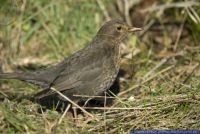Turdus merula
Blackbird
Exif Keywords: Natur, Nature, Animals, Tiere, Fauna, Voegel, Vogel, Bird, Fliegen, Fly, Aves, zoologie, zoology, federn, gefieder, feather, flying, animalia, tierreich
Exif ImageDescription: Turdus merula,Amsel,Blackbird
The Blackbird or Common Blackbird (Turdus merula) is a European member of the thrush family Turdidae. It is common in woods and gardens over all of Europe and much of Asia south of the Arctic Circle. Populations are resident except for northern birds which move south in winter[citation needed]. Urban males are more likely to overwinter in cooler climes than rural males, an adaptation made feasible by the warmer microclimate and relatively abundant food that allow the birds to establish territories and start reproducing earlier in the year[1]. The Blackbird is 23.5 to 29 cm in length. It is omnivorous, eating a wide range of insects, earthworms, seeds and berries. It nests in bushes or similar, laying several (usually 4) bluish- green-grey eggs with brown reddish marks in a neat cup-shaped nest. It does not form flocks, although several birds, especially migrants, may be loosely associated in a suitable habitat. The female Blackbird is aggressive in the spring when it competes with others for a good nesting territory. The male is also competitive and will protect its territory by chasing away other males. If a fight between male Blackbirds does occur it is usually short and the intruder is soon chased away. The male Blackbird is all black except for a yellow eye-ring and bill. The adult female and juvenile have brown plumage and a brown beak and do not have a yellow eye-ring. Overall, the juvenile is a slightly lighter brown than the female, and the very young juvenile has a speckled breast. The male sings its varied and melodious song from trees, rooftops or other elevated perches. It sings mainly in the period from March to June, sometimes into the beginning of July. In very mild winters, Blackbird song is heard in February and even in January. A Blackbird has an average life expectancy of 2.4 years and the oldest recorded age is 20 years. The Blackbird has been introduced to many parts of the world outside its native range. In Australia and New Zealand it is considered a pest and has an effect on natural ecosystems... Source:Wikipedia
Viewed 7021 times









